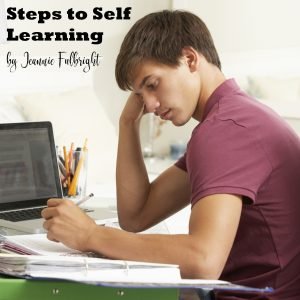Steps to Self Learning
Students who have developed a foundation of good character (no, not perfect children, but those who have a conscience about doing the right thing) and have gained personal responsibility for their education—with an eye set on the future—are prime candidates for self learning.
The first step to moving toward self learning is to carefully select curricula that is well suited for self education. This means the course can be used by the student alone, once he has grasped how it should be done. You see, after your child has learned to read (a teacher is often needed full time for this accomplishment) he is ready to “read to learn.” Adept readers can begin the process of learning on their own: reading the instructions and the text, then doing the work on their own. This process happens gradually as you begin to hand over the reigns of the course work to your child. Of course, he must understand the importance of self education and that self education is a skill that will enable him to succeed at whatever he endeavors in the future.

Some curricula are dependent on a teacher's manual. Generally, these courses are not designed by or for homeschoolers or by those who understand how homeschooling works. Homeschool curricula that are specifically designed for homeschoolers will teach to the student with the assumption that the student can read the entire course on his own to learn the material. However, an older student can incorporate the teacher's manual into the course if it's not too interwoven into the day’s lesson.
When my son completed a math lesson, he showed me his work. I gave it a once over to make sure he was on track then told him to check his answers in the teacher’s manual. It was very easy. Yet some courses require the teacher’s manual to present new material and perform little scenarios and teaching sessions. These are not suited for self education and are difficult for a student to incorporate into the course.
Each year when I went to homeschool conventions, I would look carefully at the curricula to make sure it could be completed by my children on their own, even if I intended to read the lessons to them. I needed them to take the reigns during those periods when life got hairy (I'm sure you know what I mean) and I was just too busy to focus on science, history, or math. In essence, the curriculum should be easy to use and easy to implement.
It should be fairly painless to complete a lesson and move on to the next. Don't you just hate it when your children can't finish a lesson because you still have to do something that is too hard for a busy mom to do before they have learned all that needs to be learned in the lesson? Ugh. Projects and experiments are easy to skip, but if you have to present a little ditty that will be used in the next lesson.... that's tough on a homeschool mom.
When you are first starting the process of self learning, gradually ease your children into the material. When my kids were in the elementary years, I began each year excited about school starting and had the energy to be fully involved in their course work.
Then, as the days and weeks progressed, I slowly began to allow more autonomy.
We discussed how the lessons were organized, how the material should be handled, and what was expected of them. We also discussed how they would transition without me. I was still around, checking their progress most of the time, but they began to learn the material on their own.
Much is accomplished by reading. I used narration to ensure my children’s retention of the material they read. If they complained that they didn’t understand or know what to do, I would ask for a narration of the text they read. If they could not narrate well, I knew they were not reading attentively and I would have them reread the material. This usually fixed the problem. Sometimes a layperson's explanation is in order. If I had to re-explain the text too often, it was time to shelf it and find something that promoted self learning.
I checked my children’s daily work until I felt they were ready for less intensive oversight. Within a month of starting school, the older elementary students (3rd or 4th grade and up depending on the kid) were almost completely on their own for most of their lessons.
There are some subjects that need more oversight than others during different phases of a child's academic development. When you are working on a new algorithm, like long division, you may have to sit next to the child every day until the procedure is mastered. When you are teaching new skills and new concepts, you want to oversee the process and make sure there is a level of mastery before you leave the child on his own. Leaving a child on his own too early will result in frustration for the child and a lack of progress. You will also end up overseeing subjects that don't need a lot of oversight.
Further, there are some courses that mom simply delights to do with her children, like history and science. This is understandable as we are usually learning as much as they are (if not more). What I normally did for history was assign separate reading books (historical fiction or read alouds) that corresponded with the time period. The children read these as outside reading and narrated to me each time they read. For science, I had the oldest child take charge of and do the experiments with the other children.
There are a few courses out there, like Shurley English, that offer a great deal of value for a student. Frustratingly, these courses are designed to be extremely teacher dependent. It just so happens that this is the way Shurley English wrote the program for homeschoolers. They obviously didn't know how homeschooling works or they would have written it to the student, not to the teacher.
Nevertheless, there is curricula like this that we may want to use. So if you choose to use something that is teacher intensive, think of a way that it can be maximized. For example, I waited an extra year to do Shurley so that I could teach two kids at once. I taught to the older student, but the younger was able to keep up. Also, I taught it later and only once in the elementary years.

Other ways to maximize teacher intensive curricula is to combine lessons for the lecture portion, then allow the course work to be completed over a few days. You can also organize a class or co-op and get the added benefit of social time and sharing of the teaching role. There are many ways to make it work with less stress.
There are three exceptions to this progression from learning to read to reading to learn. First, some students are simply not ready for this level of responsibility even after they have learned to read. Some personalities are slower at maturing into a steady self learner. This student is often extremely bright and inquisitive. He doesn’t trust the normal flow and structure until he’s personally convinced of its merits. These students tend to need more guidance, direction, and oversight because their personality is not as easily molded into the diligent student mode. They tend to question decisions and the benefits of uninteresting academic pursuits. They also have the ability to focus for long periods of time on that which is extremely interesting to them. These students may frustrate easily.
Further, their mind can wander quite rapidly. This child is the sanctifying child that will grow your patience and character. I know because I have one. These will be trusted with independence quite a bit later than typical kids. Most of these unique kids are ready to be independent by sixth grade, if you don't neglect devotions and training them to be led by the Spirit and not the flesh—and if you help them understand that their future is dependent upon today.
The second exception to an easy transition into self learning is the learning disabled student. Be assured that students with learning disabilities will become independent learners. They need more time for everything. Focus on the basics, read aloud, get educational videos for them to watch, get a subscription to learningstreams, and allow them to explore the world and learn outside of the box. Don't force academics before they are ready.
Some students are not learning disabled, but are simply late bloomers. Just because your child is a late bloomer doesn't mean he is learning disabled or that you are a bad teacher or that he’s a hard kid to teach. Just wait a year or two or three; he’ll catch up. No sense in making him think he’s dumb by continuing to introduce information and concepts that his little mind is not ready to digest. Rest assured he will eventually catch up with his peers. In high school, no one will know who learned to read at four and who learned to read at eleven. It won't matter that they didn't grasp subtraction until fourth grade. It just won't be important.
Read on for more homeschool encouragement.


